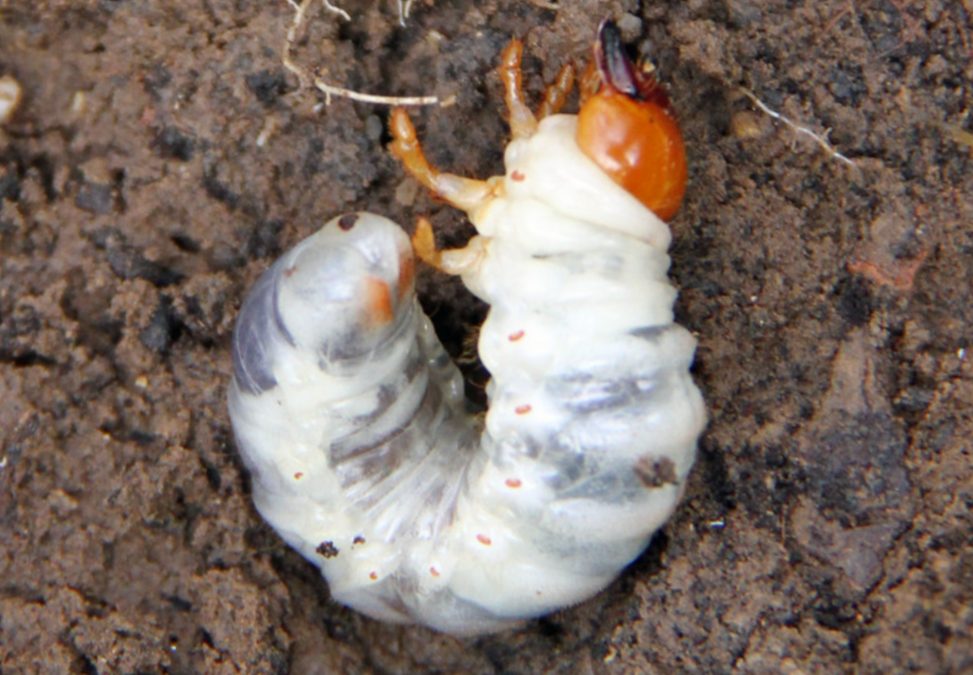We might think that bug-ugly creatures that invade and destroy lawns are the bane of hot, moist parts of the country. It’s true the Southern states suffer the worst, but no part of the U.S is free of grass-chomping insects. That includes Denver.
Yes, Denver might be cool (literally and figuratively), but they’re out there, lurking just below our feet, busily gnawing away at our carefully nurtured lawns.
Nearly all insects that can seriously hurt Denver lawns do so in their larva stage — as grub worms. Most varieties feed low on the grass blades and on roots. If you have an infestation, a chunk of sod will come up easily in your hand and you can see the little creatures squirming around.
But here’s good news! The creepy-crawlies most likely to pester Denver neighborhoods can be evicted. The best way to do it is so simple you’ll be smiling by the end of this article.
First, let’s identify the freeloaders that can lay waste to our backyards.
Billbugs
You may see these black or brown weevils strolling across your sidewalk in the warm months. While their distinctive snouts look menacing, the adult bugs actually don’t do much damage. But in their earlier stage as a white grubworm they can take a toll. The grubs like to hang out around evergreen shrubs and trees where you may see patches of wilted grass and matter that looks like sawdust. Left untreated, billbug grubs can kill your lawn.
Cranberry Girdler
An interesting name for a harmless-looking little winged creature you’ll see flitting about in the summer. The larvae will eat their way through the roots of your grass and then move on to your fir trees. In this stage, the gray grubs have distinctive orange-brown heads. Brown patches in your lawn in late summer are a clue you may have these pests.
Scarab beetles
In parts of the country where they’re numerous, these big clumsy brown bugs are often called June bugs. They like to fly around outdoor lights on summer nights and freak you out when they cling to your skin. For years, Colorado was mostly spared from this insect, but the spread of suburban lawns has increased their population. Almost every American lawn has a few June bug grubs — fat white larvae — but they’re not a problem until they become a heavy infestation.
Sod webworms
In their adult stages, these are common moths. In their larval stages, they are brownish grubs distinguished by dark spots on their back. They spin silky webs in the grass or on leaves. They are one of the most common insects in Colorado. Although they come out at night to feed on grass blades, a healthy lawn can withstand them. Also, your backyard birds are efficient and cost-effective exterminators of this poacher.
One lawn pest that is not a grub worm is the lawn mite. These nearly-invisible, spider-like little specks can wipe out a lawn if left unchecked. They prefer hot or dry weather and are not bashful about coming into your house. Fortunately, it’s easy to get rid of them.
Which brings us to the simple solution to backyard pests that will put a smile on your face:
Water!
Severe infestations may require the use of pesticides or professional help, but every infestation mentioned here can be prevented by proper lawn irrigation.
Grubs feed primarily at ground level or on shallow roots. Irrigation done in the morning at a rate of an inch per week (including rain) allows grass roots to descend deeper into the soil and become sturdier in order to withstand pest infestation.
Proper fertilizing and aeration (getting rid of matted and thatched surface vegetation) also helps.
The key word is “proper.” Overwatering may actually attract pests.
By the way, lawn mites hate water and will evacuate ASAP when soaked down.
Interested in more information about lawn care and service in Denver? Visit our Denver lawn care page.
Main photo source: Greg the Busker, Flickr

